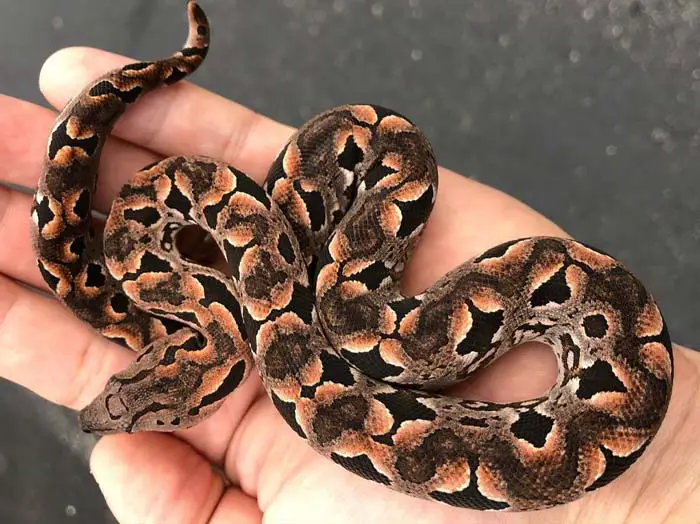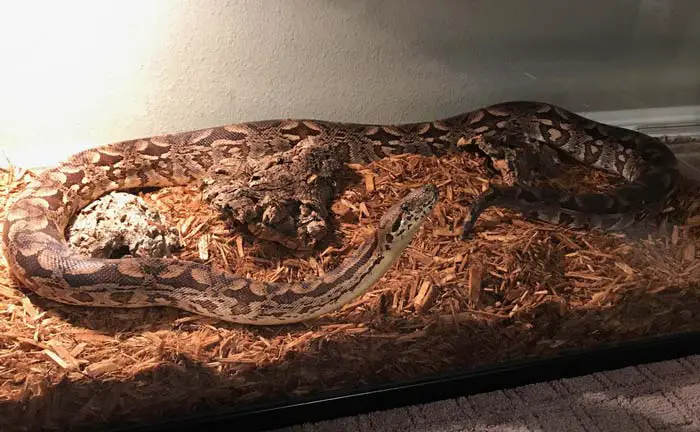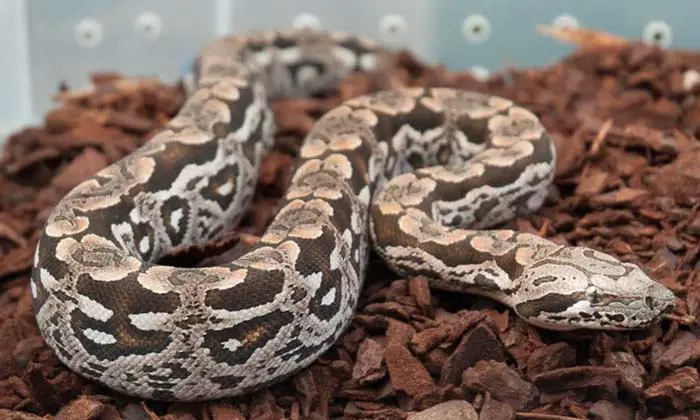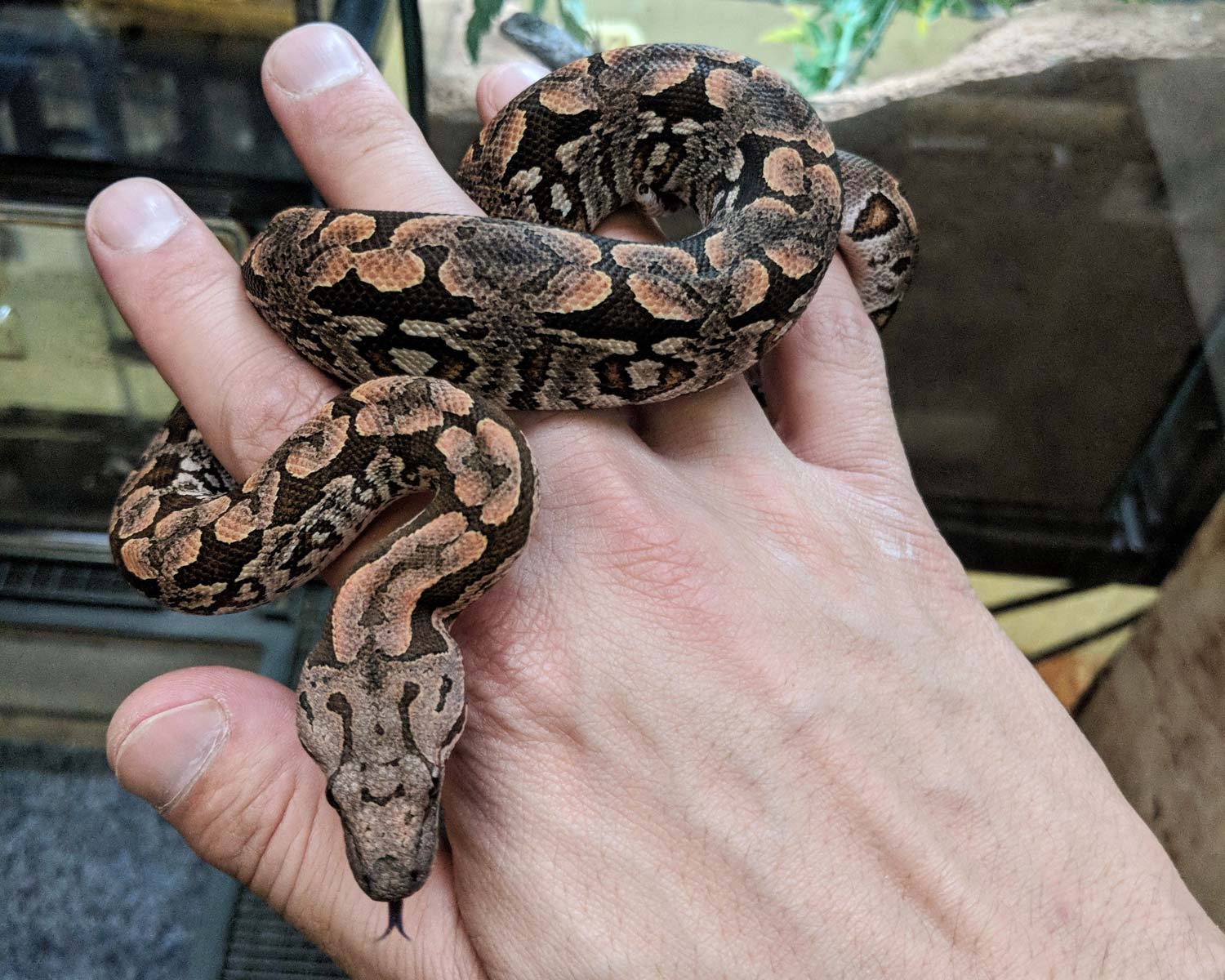It’s a snake, but it loves cuddles!
The Dumeril’s boa (Acrantophis dumerili) is part of the boa family. This means that it is a nonvenomous snake that uses constriction to kill its prey.
The Dumeril’s boa (a.k.a the Dumeril’s ground boa) has a wonderfully calm temperament, this makes it a lovely pet for reptile and snake lovers.
We have prepared a care guide for you and your Dumeril’s boa to ensure a happy and long relationship.
If you are a new Dumeril’s boa owner or are thinking of getting one you must have some questions on your mind.
Reptile Overview
| Common name: | Dumeril’s boa or Dumeril’s ground boa |
| Scientific name: | Acrantophis dumerili |
| Indigenous: | Madagascar |
| Natural habitat: | Dry forest floor with good ground cover |
| Endangered status: | CITES lists them as highly endangered |
| Maturity: | 3-5 years |
Dumeril’s boas are from Madagascar.
They live in the south/southwestern forest, coastal, and arid areas that have minimal rainfall.
In Madagascar, they are so endangered that they are nearly extinct in their natural habitat. It is illegal to export these snakes from Madagascar.
Make sure you get your Dumeril’s ground boa from a reputable exotic pet breeder or distributor.
History
Scientifically noted in 1860 by the Italian zoologist Giorgio Jan. Its scientific name Acrantophis means “lazy snake”, this is possible because of their calm and peaceful temperament or because they are ground-dwelling snakes.
They get the “Dumeril” part of their name from André Duméril, a French herpetologist.
The road to near extinction in their natural habitat:
- The Dumeril’s boa was caught and sold in the international exotic species trade because of their coloring.
- They became a delicacy in China and were shipped en masse.
- They were very popular in the leather trade; their beautiful skins were turned into belts and shoes.
The Dumeril’s boa has seen a rise in numbers in captive breeding programs and as pets across the world.
Behavior and Temperament

These boas are very peaceful and calm snakes, this makes them perfect pets.
They will happily settle down on your shoulders for a nap.
The Dumeril’s ground boa learns to trust frequent handlers (owners). This kind of behavior creates a bond between pet and owner; this is a very special bond that you wouldn’t usually expect from a reptile.
Your Dumeril’s boa does not like to be touched on the head, it will rear back to get away from you.
Some people get frightened and their actions may cause the snake to lash out and bite.
Bites are rare but do happen. Boas are nonvenomous but the bites will need antibiotics and to be cleaned thoroughly.
Are They Good Pets?
A Dumeril’s boa is an excellent pet for a slightly more experienced reptile owner.
If you want to own a boa for their temperament but a 6-9 feet (2-3m) long boa imperator is out of your capability then a Dumeril’s ground boa is perfect for you.
They do well and live a long time in captivity.
Lifespan
Dumeril’s boa lives from 10 to 15 years in captivity. Some records of 20+ years!
Appearance

They are one of the smaller boas at roughly 3-6 feet (1-2 meters) at maturity.
Neonates (baby boas) are roughly 12-18 inches (30-45 centimeters).
They are quite chubby looking snakes because they have a substantial girth (roundness to their bodies).
The females are larger than the males in both length and girth. This is because she needs extra space to store her clutch of eggs.
Both sexes have two nubs towards the end of their bodies next to the cloaca. These are pretty cool. They are evolutionary left-over legs from when snakes shared a common ancestor with legged reptiles!
The male’s “nubs” have spurs on them and they are used to stimulate a female during reproduction. The spurs are also how you tell the sexes apart.
Their heads are triangular and widen quite a bit towards the body. Some say this makes them look aggressive and some say this makes them look like dogs – you decide!
Dumeril’s boas are beautiful snakes that are very popular with reptile collectors because of their coloring.

Their coloring is called a “morph” and it varies according to the individual snake. The colors range from dark brown and gray, through red and green, to pale peach and coppery pink.
Different lights bring out different hues in the snake’s skin.
The patterning is used to camouflage the snake in the leaf litter on the ground. The dark and light patterns break up the outline of the snake and make it difficult to see by both predators and prey.
Enclosure Size

Neonates and Juveniles
Their enclosure should measure 2 ft x 2 ft x 14 inches. We recommend 24 x 18 x 18 Exo Terra Glass Terrarium Kit.
They should be in a container they cannot see out of to reduce stress. For this purpose we are using hiding boxes from Zipefy.
If you opt for a glass terrarium (10 to 20 gallon), cover part of it up or provide a dark hideaway for them to go to when they feel threatened.
The juvenile Dumeril’s boas must be housed individually because they do cannibalize.
Their enclosures must have secure lids or be stored in racks because they are surprisingly strong and will sneak out to go exploring.
At a year old, increase their enclosure size.
Adults
An adult’s enclosure should be 48″ x 24″ x 24″. This is the minimum. We recommend to use REPTIZOO Large Glass Reptile Terrarium.
REPTIZOO Large Glass Reptile Terrarium
You should always try for bigger enclosures so the snake has plenty of room to move and so there is enough room to provide a suitable temperature difference.
A glass terrarium is a good place to have the snake if you are going to have it in the house “on display” as you would a fish tank or birdcage.
You can be creative and use things like Rubbermaid containers, secure wooden boxes, plastic reptile containers, or plexiglass type tubs with secure lids.
Ensure that your snake has a dark and quiet hideaway to go to if it feels threatened or stressed. There should be a hideaway on both the cool and warm sides of the enclosure.
Substrate
The Dumeril’s boa’s natural habitat is dry leaf litter on the forest floor.
Try to mimic their natural environment with things like newspaper, brown butcher’s paper, aspen shavings, cypress mulch, or other things that will not harm your snake.
Galapagos Aspen Digs Shavings Bedding
Be aware of pesticides, they will damage the snake’s skin.
Be aware of cedar and pine. They have oils that irritate the boa’s skin and can cause neurological damage.
Your boa will need logs or rough cork items that they can hide behind and use to help them shed their skin. Remove the shed skin once it has completely fallen off of the snake.
Spot clean the substrate of droppings regularly and do a proper “whole-cage” clean once a month.
Temperature and Lighting

A Dumeril’s boa is a reptile and therefore exothermic. This means that it cannot control its body temperature as you can.
This is why careful lighting and temperature control is key in maintaining your snake’s health.
One side of your Dumeril’s boa’s enclosure will be cool and one will be warm.
Your snake should have a 12-hour cycle of light and a 12-hour cycle of the dark. This does not mean 12 hours of heat and 12 hours of no heat.
The snake must be able to move between warm and cool to regulate themselves. You should have an accurate temperature gauge on both sides of the enclosure 1 inch above the floor and one in the basking area.
Cool Side
The coolest side of the enclosure should never drop below 75°F.
The cool side of the enclosure should be 75°F to 80°F.
Make sure there is a hideaway on the cool side so that your Dumeril’s boa has a place to go when it needs privacy and a cool place to relax.
Warm Side
The warm side of the enclosure should be between 80°F (26°C) and 85°F (30°C).
It is recommended to have a heating pad underneath the tank that will heat the warm side evenly without providing additional light. Your heating pad will help control the humidity levels as well.
Put a hideaway on top of the heated area so the boa can retreat there when it needs privacy and warmth.
Basking Area
On the very end of the warm side, you should have a “basking area”.
This area should have a heat lamp over it. We are using We are using Zoo Med Repti basking spot lamps with Zilla Reflector domes.
Zoo Med Repti Basking Spot Lamp
The temperature in this area should be between 85°F (30 °C) and 90° F (32°C).
The basking lamp will be turned off in their 12 hours of “no light”. The heating pad will maintain its temperature throughout the “night-time”.
For night-time heating we recommend to use VIVOSUN Reptile Heat Mat with digital thermostat, so you will be able to adjust the required temperature.
VIVOSUN Reptile Heat Mat with Digital Thermostat
Humidity

The enclosure’s humidity level should be kept between 40% and 60%.
The boa will need the higher end of the humidity scale during its shedding phase to keep its skin moist.
Levels higher than 60% will lead to respiratory problems.
Levels lower than 40% will lead to shedding problems.
A water bowl in a non-porous container will help keep humidity levels between 40% and 60%.
Spray clean, room temperature water into the enclosure at least once a day to maintain the humidity levels. If you have a drier substrate in the enclosure or live in a drier climate you might need to spray multiple times a day.
You will need a hygrometer to monitor humidity levels.
Diet
Dumeril’s boas drink a lot of water. Your boa will need clean water every day. Fresh, filtered, or spring water is fine.
You must scrub out your boa’s water dish once a week to avoid any health issues.
Your boa will soak in the water around shedding time so make sure that the water container is big enough to fit the snake and heavy enough that it won’t tip it over.
During shedding time, if you see that the water is getting mucky, change it to prevent your boa from getting sick.
Food for Neonates to 2 Years Old
Dumeril’s boas in this age group can be fed once a week (every 7 days). Frozen (must be thawed correctly) prey is perfectly fine.
Most owners feed them hopper mice or rat pups when they are younger.
The girth of the prey should not be larger than the girth of the snake.
Food for Juveniles and Adults
Dumeril’s boas in this age group can be fed every second week (every 14 days).
Alternatively, you can maintain the 7-day feeding cycle but reduce their portions by half.
Most owners feed them rats, fowl, and rabbits depending on the size of the snake.
If your snake is not eating while it is shedding do not panic. This is normal behavior for shedding snakes. Wait until their shed is mostly over and offer them food again.

How Often Do I Feed It?
How often you feed your Dumeril’s boa will depend on its age.
If your boa is a neonate/juvenile that is accepting food, then once every 7 days.
If your boa is an adult then a good time is every 14 days.
There is more detailed information on their feeding habits further on in this guide.
Handling
Always make sure your hands are clean when handling your snakes. They are very susceptible to disease.
Do not handle your boa while it is eating or for 24 hours after it has eaten.
Most Dumeril’s boa owners suggest that you hook train your snake.
Your snake is smart enough that after a while, it knows that if it is being ‘hooked’ then it is either feeding or handling time.
Simply reaching into your boa’s enclosure can cause it to panic and try to escape to its hideaway.
Your hook training needs to be consistent and gentle. You do not want your snake to associate being ‘hooked’ with pain and panic.
This will cause the snake stress and it may lash out at you.
Gently nudge your boa with the hook, then pull it partway out of the container before you attempt to hold it.
When you handle the boa, be gentle and calm with it. Always support its weight.
Dumeril’s boas are very curious creatures, they will generally want to explore you a bit before settling down for a cuddle.
Avoid touching the top of your boa’s head. They cannot see you and will rear away from you in fear.
Many people misunderstand this action and they get a fright.
They can either drop the snake or squeeze it too tightly which will result in harm to the snake and a possible bite to the handler.
Potential Health Issues
Before you obtain your Dumeril’s boa, research exotic vets in your area and find out if they have the knowledge to be your snake’s doctor.
Remember, Dumeril’s ground boas can live for 20 years, a pet that lives that long needs a good vet that you can turn to in case of emergencies.
As we have said before, your Dumeril’s boa and snakes, in general, are very susceptible to disease. Listed here are some of the most common issues for your boa.
Respiratory Issues
If the humidity level is too high in the boa’s enclosure then it can develop a respiratory (breathing) problem.
If you notice bubbly mucus coming out of its mouth or nostrils, take it to the vet immediately.
Other tell-tale signs are weight loss and lethargy.
Mites
Mite infestations are incredibly common with Dumeril’s boas.
Look out for your snake spending a large amount of time in its water when it is not shedding.
Other tell-tale signs are patches on its skin being covered with red or black dots.
Mites tend to go for the eyes, nostrils, and the gular fold (by the chin).
Keeping your boa’s enclosure clean and ensuring that your hands and equipment is properly sanitized will help prevent spreading infestations and infections.
Obesity
New owners may tend to overfeed their boas. This will result in obesity.
Your snake will become lethargic and listless with an obvious increase in weight.
This is not a cute or funny condition as it can lead to liver and heart failure.
Contact your exotic pet vet for an exam to ensure that nothing else is wrong and then adjust the feeding schedule.
Communicable Diseases
- Stomatitis
- Internal parasites (coccidia and worms)
- External parasites (mites and ticks)
- Skin infections
- Inclusion body disease
Breeding

It is recommended that you keep your males and females separate, males will mate with females throughout the year if they are allowed to.
If you have more than one male vying for the female’s attention, they will fight each other and can injure each other badly.
Sexual maturity is reached between 3 and 5 years.
Do not stop feeding your Dumeril’s boas during breeding time. During gestation, feed the female smaller prey items so there are no digestion issues.
Introduce you male and female boas in October, keep to one male per container.
Your Dumeril’s boas will either breed during the cooling period or the warming period, there is no set time:
- Start cooling the females in late October to early November. The hottest spot should be very gradually cooled to 80°F (26°C) during the day and turn the heating pad off completely at night. This leads to a period of brumation which is essential for successful breeding to occur.
- In late January to early February slowly start warming the boa’s enclosure back up and leave the heating pad on at night again.
If breeding was successful then you will begin to see a small lump in the female’s body.
Leave the male in the enclosure until you are 100% sure the female is pregnant, usually by March.
Gestation can be up to 9 months. Depending on which period the boas mated in, the babies will be born between August and November.
Remember that Dumeril’s ground boas are ovoviviparous and will not lay eggs like some other pythons and boas.
Your Dumeril’s boa is nearing their birthing time when she sheds, this is when you should isolate her.
Males can and will attack a female giving birth, they will also can eat babies.
Once she has given birth, remove her from the birthing enclosure and watch the neonates carefully.
They are born with a yolk sack. Do not move them until they have fully absorbed their yolk sack. These are essential nutrients for the neonates.
Once the yolk sack has been absorbed you can remove the boas and put them in separate enclosures (shoeboxes with a water bowl, hideaway, and some damp paper towel are perfect for when they are just born).
They must be kept individually as they will cannibalize each other.
How Many Babies Will It Have?
Dumeril’s boas give “live’”birth. This means that the eggs hatch inside the female’s body and the live baby boas are born through the cloaca.
An average litter is about 6-13 but can go as far as 20.
The breeding of Dumeril’s ground boas is a complicated business, make sure your breeder takes care of all of their snakes.
Conclusion
Dumeril’s boas (Acrantophis dumerili) are lovely snakes to have as pets. They are not too big so maintenance and enclosure size is manageable. These snakes are intelligent and will come to recognize their handlers.
These boas are long-lived and make perfect quiet companions. The Dumeril’s ground boa is almost extinct in its natural habitat in Madagascar and so its survival is firmly in the hands of breeders and loving herpetologists.
If you are looking to own or start breeding Dumeril’s boas then we “Herp” you have a wonderful journey and a long and happy relationship with your new boa friend.
Related:







